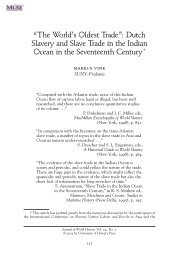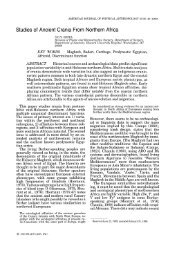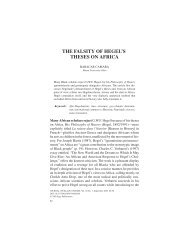Nubian Queens in the Nile Valley and Afro-Asiatic Cultural History
Nubian Queens in the Nile Valley and Afro-Asiatic Cultural History
Nubian Queens in the Nile Valley and Afro-Asiatic Cultural History
Create successful ePaper yourself
Turn your PDF publications into a flip-book with our unique Google optimized e-Paper software.
N<strong>in</strong>th International Conference for <strong>Nubian</strong> Studies August 20-26, 1998<br />
Museum of F<strong>in</strong>e Arts, Boston U.S.A<br />
The Russian scholar Kobishkhanov <strong>in</strong><br />
analyz<strong>in</strong>g <strong>the</strong> story of Makeda <strong>in</strong> <strong>the</strong> Ethiopian<br />
Kebra Nagast ("Book of K<strong>in</strong>gs") sees her more as a<br />
co-regent with her son Menelik, not<strong>in</strong>g that "ancient<br />
Ethiopian queens were co-regents with <strong>the</strong>ir sons or<br />
bro<strong>the</strong>rs, <strong>the</strong> queen be<strong>in</strong>g able to eclipse her coruler<br />
son only if he were very young"<br />
(Kobishkhanov 1979, p. 199). Also accord<strong>in</strong>g to<br />
<strong>the</strong> Kebra Nagast Makeda/Sheba modified strict<br />
female succession <strong>and</strong> rule, where only females<br />
reign, to one of male regency through females. She<br />
transmitted <strong>the</strong> throne to her son <strong>and</strong> decreed that<br />
"from now on <strong>in</strong> Ethiopia men will reign <strong>and</strong><br />
women will not reign." Religious texts be<strong>in</strong>g a<br />
guide but not precise history, after Makeda's decree<br />
<strong>the</strong>re were 12 queens listed as sovereigns <strong>in</strong> <strong>the</strong><br />
official state Chronicle, not <strong>in</strong>clud<strong>in</strong>g Zaudita who<br />
reigned as empress <strong>in</strong> <strong>the</strong> 20th century (Rey 1927).<br />
The possibility that co-regency as a<br />
function of matril<strong>in</strong>eal succession is a broader<br />
African cultural pattern is suggested by its presence<br />
<strong>in</strong> cases as dist<strong>in</strong>ct as <strong>the</strong> Shilluk, where bro<strong>the</strong>rsister<br />
marriage was practiced <strong>in</strong> <strong>the</strong> royal l<strong>in</strong>e, <strong>and</strong><br />
<strong>in</strong> Sudanese <strong>in</strong> post-Islamic k<strong>in</strong>gdoms or sultanates.<br />
The Funj Sultanates of S<strong>in</strong>nar, <strong>the</strong> first of <strong>the</strong><br />
Islamic k<strong>in</strong>gdoms of <strong>the</strong> Sudan, practiced<br />
matril<strong>in</strong>eal descent, possibly derived from <strong>the</strong><br />
<strong>Nubian</strong> holy men who, with Blue <strong>Nile</strong> peoples,<br />
comprised <strong>the</strong> first Unsab l<strong>in</strong>eage of S<strong>in</strong>nar<br />
(Spauld<strong>in</strong>g 1985). This cont<strong>in</strong>ued through <strong>the</strong><br />
Amara Dunqas l<strong>in</strong>e until 1720 CE. The Sultanate of<br />
Darfur had a pattern of bro<strong>the</strong>r-sister rule which<br />
lasted from <strong>the</strong> Middle Ages until its defeat at<br />
British h<strong>and</strong>s <strong>in</strong> 1916 (Theobald 1965). The title of<br />
<strong>the</strong> rul<strong>in</strong>g sister dur<strong>in</strong>g <strong>the</strong> Middle Ages was "Iya<br />
Bassi" who, after her bro<strong>the</strong>r, was above all o<strong>the</strong>r<br />
male officials <strong>and</strong> all women (Mohamed 2002).<br />
For <strong>the</strong> documented cases described where<br />
<strong>the</strong>re is a historical pattern of rul<strong>in</strong>g queens <strong>and</strong><br />
matril<strong>in</strong>eal succession few were hegemonic states<br />
with large empires to defend. Elsewhere I have<br />
written that matril<strong>in</strong>y can survive early state<br />
formation but tends to disappear after a threshold of<br />
empire build<strong>in</strong>g where endemic warfare is a major<br />
characteristic of <strong>the</strong> state (Fluehr-Lobban 1988).<br />
On a global scale matril<strong>in</strong>y decl<strong>in</strong>ed <strong>in</strong> <strong>the</strong> face of<br />
<strong>the</strong> modern nation-state, <strong>and</strong> it was especially<br />
5<br />
assaulted by European colonialism. It is possible<br />
that matril<strong>in</strong>y did not hold up well <strong>in</strong> <strong>the</strong> face of <strong>the</strong><br />
ancient hegemonic states ei<strong>the</strong>r, which expla<strong>in</strong>s<br />
why it is not as apparent <strong>in</strong> <strong>the</strong> great city-states <strong>and</strong><br />
empires of Mesopotamia, <strong>and</strong> is only weakly<br />
represented <strong>in</strong> Pharaonic Egypt. It is tell<strong>in</strong>g that <strong>the</strong><br />
rival but smaller states of Nubia expressed stronger<br />
patterns of matril<strong>in</strong>y, which may provide one<br />
explanation of why <strong>the</strong> presentation of <strong>the</strong> few<br />
female pharaohs of Egypt is so different from <strong>the</strong><br />
impos<strong>in</strong>g, womanly figures that were struck as<br />
images of <strong>the</strong> K<strong>and</strong>akes.<br />
2. Fem<strong>in</strong><strong>in</strong>e Orig<strong>in</strong> Myths, Foundresses of<br />
Cities <strong>and</strong> Dynasties<br />
It has been already mentioned that Makeda<br />
was <strong>the</strong> founder of <strong>the</strong> Menelik dynasty <strong>in</strong> Ethiopia<br />
<strong>in</strong> <strong>the</strong> 9th century BCE <strong>and</strong> that Gudit founded <strong>the</strong><br />
rival Zagwe Jewish dynasty <strong>in</strong> <strong>the</strong> 10th century CE.<br />
As <strong>the</strong> history of Kush-Meroë becomes better<br />
known <strong>in</strong> <strong>the</strong> future, especially after <strong>the</strong> Meroitic<br />
script can be read <strong>and</strong> analyzed, perhaps some<br />
queens may be acknowledged as founders of<br />
dynasties.<br />
"Al-Kah<strong>in</strong>a", <strong>the</strong> Berber warrior queen,<br />
effectively founded <strong>the</strong> first Arab dynasty by<br />
send<strong>in</strong>g her two sons to fight with <strong>the</strong> Arabs before<br />
her own imm<strong>in</strong>ent defeat <strong>and</strong> execution; <strong>the</strong> sons<br />
were <strong>the</strong>n accepted <strong>and</strong> became <strong>the</strong> founders of <strong>the</strong><br />
confederation of <strong>the</strong> Berbers (Norris 1982,52). The<br />
orig<strong>in</strong> myth of <strong>the</strong> matril<strong>in</strong>eal al-Haggar Tuareg is<br />
based upon <strong>the</strong> mythical Queen T<strong>in</strong>-H<strong>in</strong>an <strong>and</strong> her<br />
female companion Takama, ei<strong>the</strong>r her sister or her<br />
vassal, each of whom became an ancestress of <strong>the</strong><br />
respective noble camel-breed<strong>in</strong>g <strong>and</strong> vassal goatbreed<strong>in</strong>g<br />
branches of <strong>the</strong> Tuareg (Keenan 1972,<br />
348). An exploration of <strong>Nubian</strong> orig<strong>in</strong> myths, given<br />
<strong>the</strong>ir matril<strong>in</strong>eal tendencies, might yield <strong>in</strong>terest<strong>in</strong>g<br />
comparative data regard<strong>in</strong>g foundresses of regal<br />
l<strong>in</strong>es or of cities.<br />
3. Warrior <strong>Queens</strong>; Women at <strong>the</strong> Battlefield;<br />
"Lady of Victory" Tradition




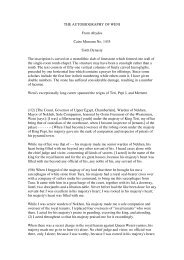
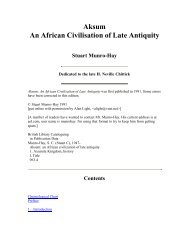
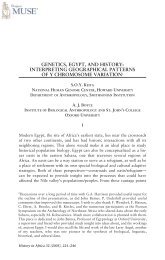

![The Negro trail blazers of California [microform] : a ... - Homestead](https://img.yumpu.com/32436613/1/174x260/the-negro-trail-blazers-of-california-microform-a-homestead.jpg?quality=85)
